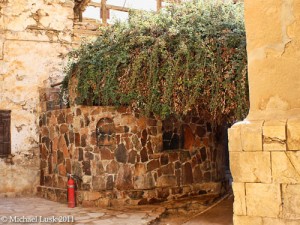This sermon on the “Unburnt Bush” in Exodus chapter 3 was great fun to prepare and very helpful upon reflection. I broke a cardinal rule in sermon-onics by one too many introductory comments but I just could not resist. Below the sermon audio is the sermon text (they are not, ever, exactly the same).
Click below for sermon audio
Trinity Church, Newport RI
Sunday February 28th 2016
The Reverend Alan Neale
“Just Keeps on Going”
Exodus 3:2 “The bush was blazing, yet it was not consumed.” Hence the title of my sermon, with thanks to a television commercial, “It just keeps on going.”
 This classic, memorable example of consumption without decrease, of use without exhaustion, of labor without burn-out… this bush, burning but not consumed, has been examined by many a Bible student – I hesitate to say scholar.
This classic, memorable example of consumption without decrease, of use without exhaustion, of labor without burn-out… this bush, burning but not consumed, has been examined by many a Bible student – I hesitate to say scholar.
Benny Shanon, professor of cognitive psychology at the Hebrew University of Jerusalem wrote a paper, “Biblical Entheogens: a Speculative Hypothesis”, in the philosophy journal Time and Mind. He suggests Moses was under the influence of a hallucinogenic substance when he witnessed the burning bush. He concludes “I have no direct proof of this interpretation” and “such proof cannot be expected.” Well, thank you, Professor Shannon!
Alexander and Zhenia Fleisher relate the Biblical story to the plant Dictamnus. They write, “Intermittently, under yet unclear conditions, the plant excretes such a vast amount of volatiles that lighting a match near the flowers and seedpods causes the plant to be enveloped by flame. This flame quickly extinguishes without injury to the plant.” They write this in the Journal of Essential Oil Research; now that’s a journal I must start reading. Colin Humphreys starkly and wryly replies “the book of Exodus suggests a long-lasting fire that Moses went to investigate, not a fire that flares up and then rapidly goes out.”
And, final attempt at de-mystification (!), I promise. In Eastern Orthodox parlance, the preferred name for the event is The Unburnt Bush, theology and hymnography view it as prefiguring the virgin birth of Jesus. Mary, the mother of Jesus, the Theotokos (“God bearer”), is viewed as having given birth to Incarnate God without suffering any harm, or loss of virginity, in parallel to the bush being burnt without being consumed. Note, “without suffering any harm”… I presume that was written by a man!
All of these attempts at rationalization refuse to do what Moses did and for which God rewarded him, they refuse to practice an essential part of the spiritual life – listen Exodus 3:3 (Message Translation) “Moses said, ‘What’s going on here? I can’t believe this! Amazing! Why doesn’t the bush burn up?’’. They refuse to practice mindfulness, reflection. To complicate a simple dictum – they refuse to “discontinue pedestrian activity and use olfactory sensory neurons in juxtaposition to methylxanthine alkaloid”; they do not stop to smell the coffee.
Moses turned aside and looked; his primary question was not “how is this happening?” but rather “what does this mean?” His primary interest was not “where is the answer to this” but rather “where is God in this”.
But… it seems to me that Moses’ question “Why doesn’t the bush burn up?” is never answered; do you agree?
Yet, friends, I believe this is a crucial inquiry. We want to know how we can be given to constant pastoral care without chronic neglect of self. We want to know how we can be persistent in hope without becoming resigned to status quo. We want to know how we can labor extensively without incurring excruciating burn-out. We want to know! Well, so did Moses.
And the answer…? Well, as of yesterday, I find an answer in Exodus 3:6, 14. Verse six “I am the God of your father, the God of Abraham, the God of Isaac, and the God of Jacob.” Verse 14 “I AM WHO I AM”, also patient of these translations “I am what I am, I will be what I will be.”
The embrace of self-identity (the immersion in confidence, acceptance, security) all this makes it possible to burn yet not be consumed. The frantic desire to people-please, the frenetic activity to conceal the real self – this and more consumes us, erodes our deepest psyche, acts like termites eroding the very foundation of our souls. For the Lord God this is a done-deal, moment by moment, age by age. For us it is a process… of recovery, relapse and, please God, recovery. We feel our hearts and minds resonating with the avowed commitment and intention of the Psalmist, Psalm 63 verses 1 & 3 “O God, you are my God, I seek you, my soul thirsts for you; my flesh faints for you, as in a dry and weary land where there is no water… your steadfast love is better than life.”
We believe that the Lord loves us with a steadfast love – immoveable, constant, irrevocable, endless. We see that love in the birth, life, death and resurrection of Jesus. Knowing this, really knowing this, enables us to burn but not be consumed, spent but not depleted.
Without hesitation I recommend Bruce Feiler’s “Walking the Bible”. Mr. Feiler writes of a visit to St. Catherine’s Monastery in the Sinai desert; the supposed site of the burning bush. A photograph shows a resplendent shrub, protected by a stone wall. The reader is invited to look closely at the photograph and then you see it… a fire extinguisher. There is much that assails our identity as God-loved, that threatens to extinguish us. This will not happen as we surrender daily to the One who says, “I AM” so that we also may say without shame or fear “I AM”.
AMEN

